Country guides

Things to do in Ethiopia
There's plenty to see and do in the ancient country of Ethiopia, but getting to attractions isn't always easy. However, many of the attractions are incredibly impressive and it's worth negotiating the chaos for a sight of them.
Most tourists travel to the colourful capital of Addis Ababa to start their exploration, and it's worth spending at least a day here to experience the vibe of this enormous African city. Visitors will find lively markets and fascinating attractions, such as the Ethiopian National Museum, which is home to Lucy, the famous early hominid fossil.
Northern Ethiopia holds the greatest attraction for visitors, as it's one of the country's richest regions for culture, history and natural splendour. The Historic Route has some breathtaking assets and is a fairly well-beaten trail on which travellers can feel safe.
With more castles, palaces and churches than any other city in Africa, the medieval city of Gondar is a wondrous place. Not to be outdone, the city of Axum is said to contain the Ark of the Covenant, as well as the ancient capital of the Queen of Sheba.
The ancient city of Harar, fourth holiest city in the world for Islam, boasts 82 mosques within its fortified walls, but Ethiopia's top attractions are undoubtedly the 13th-century rock-hewn churches of Lalibela. They are among the most incredible manmade structures in the world, revered and renowned among Ethiopians and foreigners alike, and the venue for some of the most famous religious festivals in Ethiopia. Having taken at least 24 years to complete, the astounding churches are believed to have been created with the help of angels.
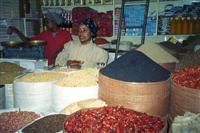
Mercato
The Mercato is one of the largest outdoor markets in Africa and Addis Ababa's most colourful sight. Ideal for souvenirs, there are tailors, spice merchants, and purveyors of just a…
Mercato
The Mercato is one of the largest outdoor markets in Africa and Addis Ababa's most colourful sight. Ideal for souvenirs, there are tailors, spice merchants, and purveyors of just about every commodity under the sun, including wonderful Ethiopian coffee. Mercato is memorable but not for the faint hearted, given its wandering animals, hollering vendors, and riot of colour, aromas, and sensations. The spice market is particularly interesting, with its exotic colours and smells. The Mercato is a pick-pocketing hotspot so visitors should be careful with their valuables. It's best to wear a money belt under clothes rather than keeping cash in an accessible place. Shoppers should bargain hard as prices are enormously flexible and foreigners are routinely charged three to four times the going rate.
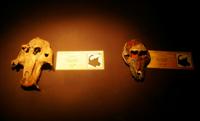
National Museum of Ethiopia
This museum displays a varied range of exhibits across three floors, and they cover Ethiopian history from the prehistoric to the contemporary. The museum is not world-class in ter…
National Museum of Ethiopia
This museum displays a varied range of exhibits across three floors, and they cover Ethiopian history from the prehistoric to the contemporary. The museum is not world-class in terms of its facilities or exhibition space, but it does contain some genuinely fascinating artefacts and gives visitors a good historical overview of Ethiopia. The most famous exhibit is the replica statue of Lucy, thought to be the oldest hominid skeleton ever found and estimated to be 3.18 million years old. Lucy was discovered in 1974 and named for the Beatles song. The fragile original skeleton is in the vaults of the building. Also of interest is the selection of celebrated Ethiopian artworks from Axum, Lalibella, and the Tana Monasteries, as well as relics from Haile Selassie's reign.
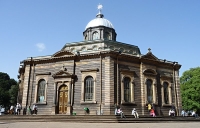
St George's Cathedral
St George's Cathedral was founded by the great Emperor Menelik to commemorate his 1896 victory over the invading Italian army. A relic of St George was carried into battle by the E…
St George's Cathedral
St George's Cathedral was founded by the great Emperor Menelik to commemorate his 1896 victory over the invading Italian army. A relic of St George was carried into battle by the Ethiopians and the emperor built the cathedral to pay tribute to the saint that ensured his victory. The cathedral is a holy place of pilgrimage for Rastafarians. It has a traditional Ethiopian design and octagonal shape, and the outer walls of the building are covered in wonderful artwork and mosaics, including work by Afewerk Tekle, one of Ethiopia's most celebrated artists. Inside, beautiful stained-glass windows enhance the sacred atmosphere. In 1930, the church hosted the coronation of Emperor Haile Selassie and he and Empress Menen are two of the famous Ethiopians buried here.
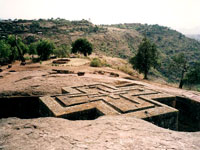
Lalibela
Lalibela is one of the world's most remarkable spiritual sites and Ethiopia's greatest tourist attraction. It's home to the country's astounding rock-hewn churches and is an import…
Lalibela
Lalibela is one of the world's most remarkable spiritual sites and Ethiopia's greatest tourist attraction. It's home to the country's astounding rock-hewn churches and is an important pilgrimage site for Ethiopia's Orthodox Christians. There are 11 functioning churches in total, all carved from a single piece of granite. The churches were carved from the top down and some lie nearly hidden in deep trenches, while others stand in open caves. Each is unique. The churches are connected by a labyrinth of tunnels and dark narrow passageways with crypts, grottos, caverns, and galleries hewn from the red rock. They were carved between the 10th and 12th centuries in a bid to create a New Jerusalem for those unable to pilgrimage to the Holy Land.
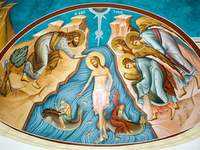
Axum
Axum is a city in far northern Ethiopia. Its 17th-century Church of St Mary of Zion is said to house the Ark of the Covenant, which visitors aren't permitted to see. Colossal stone…
Axum
Axum is a city in far northern Ethiopia. Its 17th-century Church of St Mary of Zion is said to house the Ark of the Covenant, which visitors aren't permitted to see. Colossal stone obelisks dating back to 300 AD are remnants of the Kingdom of Aksum and are recognised as remarkable historical artefacts by UNESCO. In 2005 one such obelisk was returned to Ethiopia with great fanfare after having been looted by Italy in the early 20th century. The largest number of these impressive sculptures is in the Northern Stelae Park, and the tallest one that remains standing is King Ezana's Stele, which is over 78 feet (24m) tall and weighs 160 tonnes. Some tombs have been excavated under the giant stele, but archaeologists have not yet explored the vast majority of this fascinating underground world, and the extent of the mysteries the obelisks guard is unknown.
Harar
Harar is a fascinating, exotic town of considerable interest to visitors willing to make the 320-mile (520km) journey east from Addis Ababa. Harar is the fourth holiest city in Isl…
Harar
Harar is a fascinating, exotic town of considerable interest to visitors willing to make the 320-mile (520km) journey east from Addis Ababa. Harar is the fourth holiest city in Islam and was forbidden to outsiders until 1887, when it became part of the Ethiopian Empire. Harar boasts about 82 mosques (three from the 10th century) and 102 shrines. The city is perched on the eastern wall of the Great Rift Valley, affording it a cool climate and wonderful views of the soaring mountains to the east. The main attractions are inside the Walled City, a fascinating warren of medieval mosques, houses, and markets. Another popular attraction is the nocturnal Hyena Man, who feeds wild hyenas strips of raw meat suspended from his mouth and sticks.


